The Coscoroba Swan stayed almost all year round in the reserve. When the ponds dried in summer they abandoned the place to come back the following breeding season. So they behaved till 2008 when the big drought left the ponds without water and without swans, among other waterbirds. With these works water will be available all year round and we will have to study how they will behave from now on.
Anyway, according to literature on coscoroba swans pairs come back to the same place to breed. Independently of whether the pair is the same or they occupy the same space, we witness fights to get hold of the territory every year. The pair to arrive first takes over the whole place. But as other pairs pretend a part of it conflict is always present. The persistnace of the intruder ends up winning over the owner, which accepts the presence of the newly arrived either by exhaustion or resignation. They establish a virtual limitr which will be respected by both. In this way more pairs may settle down forming a brreding site keeping distance one from the other.
Once the area has been defined, the most appropriate place to build the nest must be located. They usually build it over islets, in reedbeds or partially floating at the edge of a water mirror. Both adults get down to the task. They use the nearby material. They build the nest at distance's neck. Fixed in a place they pick the material with the bill, rotate the neck and dump it on the pile. If they are out of reach they work synchronously passing the material over to one another. They raise the platform some 40 cm above water level with a depression lined with herbs. It is a big nest easy to be spotted.
|
Phots in video © Roberto Ares This nest was build in the Coypu Pond in 2007. On 30th of June this coscoraba swan was moving the material. At the end of our walk that same day they had already raised this pile. |
|
Fotos en video © Roberto Ares Works go on July 1st. |
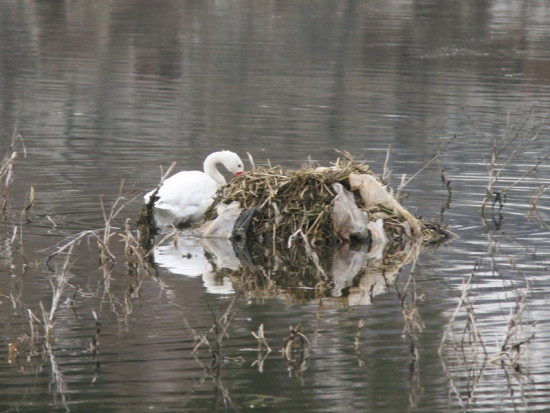 © Roberto Ares © Roberto AresOn July, 7th during the construction 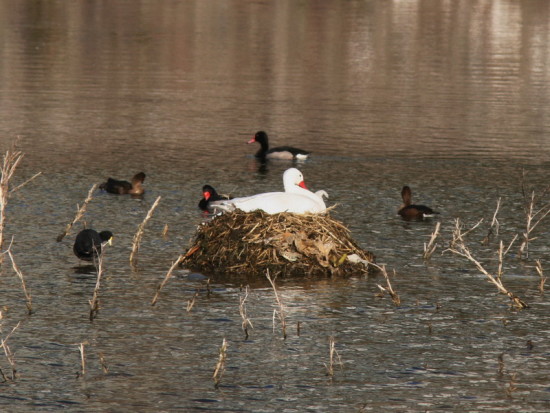 © Roberto Ares © Roberto AresBy July 14th incubation has already begun. According to these records it took them almost two weeks to finish the nest. |
The famle sits on eggs and the male stays nearby. The female ckecks the temperature of the eggs with the bill. When she leaves the nest to feed, she covers the eggs with feathers.
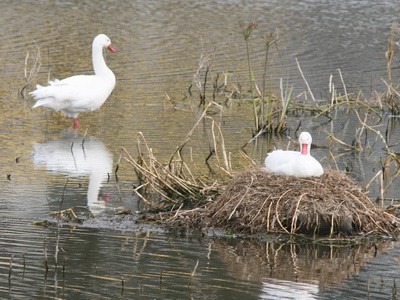 © Roberto Ares © Roberto Ares
|
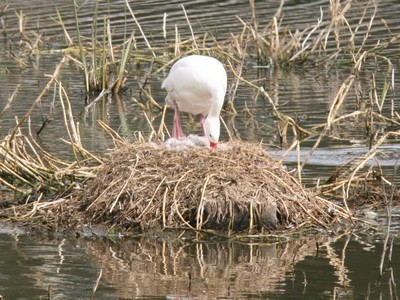 © Roberto Ares © Roberto Ares
|
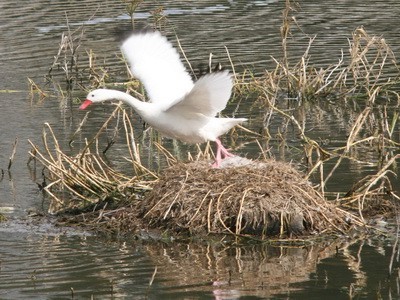 © Roberto Ares © Roberto Ares
|
They may lay up to ten eggs. Eggs hatch simultaneously and develop evenly. Cygnets are precocial. They are born with open eyes and covered in down. They follow their parents but they feed on their own. They stay in the nest a few days but then they abandon it completely. As newly born they are white with grey marks and have a dark spot on the head. The bill is very small and grow very fast.
Unlike Black-necked Swans the Coscoroba Swans do not ride their young on the back. Both male and female raise the cygnets and protect t5hem from predators.
|
© Roberto Ares Going back to the photos. The incubation began on July 14th and by August 28th we witnessed the moment when they left the nest. In this case it was more than 40 days. |
In 2013 with coscoroba swans back in the pond we made a follow up of the cygnets' developmental cycle. See the sequence

